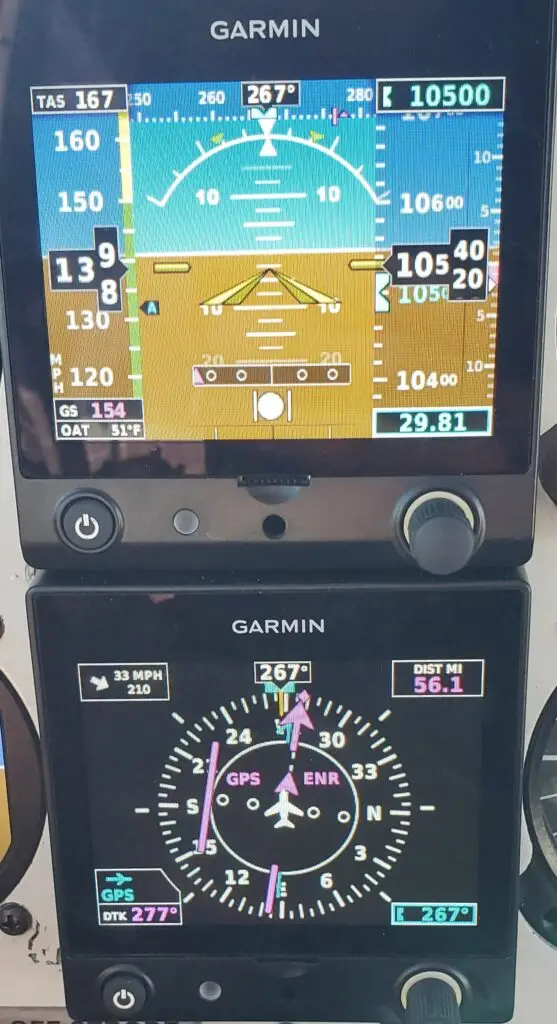IFR, Instrument Flight Rules, flying solely by reference to instruments, is most often associated with flying in the clouds but could also be flying at night over water or over sparsely populated areas where you have no ground reference. I have wanted to obtain my instrument rating for awhile but was waiting until I had a GPS in the instrument panel. I could have done it with the one NAV/COM I had in the panel, but flying IFR with a single NAV was not appealing.
I began studying for the IFR Written Exam last Summer but was not consistent in my studies. I set a goal to pass the written exam by the end of 2020 and to put the pressure on I scheduled and paid for the exam which got me studying more earnestly. You must have a 70% to pass, but I didn’t want to just “get by” with a passing grade and set a goal of getting at least 90% on the test. The date arrived, I went and took the test, and when they handed me the sheet with the grade on it I saw a 92%. The year had not come to an end and I had completed the written exam with (barely) better than 90%, mission accomplished.
Yesterday I began the flying portion of the training. Before taking your IFR check ride you must have a minimum of 40 hours of actual or simulated instrument flying. I had the required three hours in my logbook that you need for your Private Pilot but nothing more and it had been over four years and almost 500 hours of flying since the last time I flew “under the hood,” and it was about to show.
I got to the hangar early on Saturday to pre-flight the plane before the CFII arrived. He got there and went over my log book and the log book for the plane. Next we talked about the overall plan for my training and the plan for the day which would just be a flight to a local practice area and working on climbs, descents, turns, straight and level flight, and unusual attitude recoveries while under the hood.
The “hood” that I have is a pair of “Foggles” which restrict your view to just the panel in front of you.

I went through a pre-flight briefing with him, going over the radios in the plane, the audio panel, the way the flaps and gear work (he had not flown in a Mooney with manual gear), and just making sure he understood the systems in my plane.
After a run-up we departed on runway 24 and made a right turn to the north-east heading for the La Habra practice area, climbing up to 3,500′. I gave him control of the plane while I put the Foggles on and then took the plane back from him at which point I felt like a brand new pilot again.
I have Garmin G5’s in the panel which are a great little instrument. they aren’t dependent on a vacuum pump so you don’t have to worry about the vacuum pump failing and the gyro spinning down. They also have a lot of information right there on the one instrument. instead of just an attitude indicator, it also has heading, turn rate, bank angle, a speed tape, altitude tape, and vertical speed indicator.

You would think that with all that information that you would easily take it all in but I found myself getting stuck fixating on just one part of it which is not uncommon for a beginning IFR student. It does however cause you as the pilot a lot of problems. The first turn he gave me I found myself over banking and ending up in a descending left turn instead of just straight and level.
He would give me a heading to turn to and I would make the turn and roll out late, overshooting my heading. The next turn I would roll out early and undershoot the heading all the while either losing or gaining altitude. About the time I would get settled in on the heading and mostly flying straight and level he would give me another turn to a new heading.

I would spend the rest of the flight mostly chasing the instruments and feeling like I was way behind the plane. Toward the end of the flight we did some unusual attitude recoveries. An unusual attitude is when you get your plane into an attitude not normally required for flight, for example a steep climbing or descending turn. We reviewed the recovery procedures and then I gave him control of the plane and looked down at my lap.
“You’ve got the plane” he said after a little maneuvering. I looked up at the instruments and saw that we were in a climbing right turn so I added some power, pushed the nose over, and rolled the wings level. I gave him the plane back and looked down at my lap again. After some more maneuvering he said “You’ve got the plane” again. this time I looked up at the instruments and saw we were in a descending left turn. I pulled the power back, rolled the wings level, and eased back on the yoke to bring us put of the descent.
“Ok, those ones were easy” he said, “so let’s do something different. This time I want you to keep control of the plane but look down at your lap and try to fly what I tell you. The idea is to simulate something normal like looking down at your tablet or kneeboard and lose track of what you are doing.”
I looked down at the tablet on the yoke and he said “Give me a right turn and try to keep it as level as you can.” I rolled into what I thought was a nice easy right turn but after I think about three or four seconds he said “ok, recover.” I looked up at the instruments to see that what I thought was an easy right bank was actually about 10 degrees nose down and approaching a 30 degree bank. In less than five seconds of looking down I was entering the beginning of a graveyard spiral. “Wow, that happens fast” I said.
He said “Let’s do it again, but this time give me a nice level turn to the left.” I looked down at my lap again and began a left turn. This time I tried really hard to compensate for what I anticipated would be a descending left turn and made it about seven seconds before I could hear a change in the pitch of the engine and said “We’re descending aren’t we?” He replied “Yep, go ahead and recover.” I looked up and while not as bad as the first attempt we were in a descending left turn. It was great to experience how quickly it can all go wrong even when you are trying to keep it from going wrong.
“Man, I was really trying not to end up in a descent again,” I said.
“You did really well for about the first four seconds,” was his reply.
He gave me a new heading to fly and pulled up the RNAV GPS approach to runway 24 at Fullerton for our return. I flew through the final approach course and had to come back to it. In another example of task saturation from the flight I was looking at the vertical deviation which clearly showed that we were above glideslope but my brain was telling me we were below it. As I held level flight and watched us get further and further from the glideslope I finally said “Is this telling me I’m above or below?” It was a ridiculous question as I know what the instrument means and have often used it when in VFR conditions just for fun to practice, but my brain was overloaded and just not processing any additional information. As I said earlier, it was like being a brand new student pilot again.
At about five miles out he took the plane back so I could take the Foggles off an then gave the plane back to me. I leveled off to get down to gear speed, dropped the gear, pulled the power and put it in a forward slip to drop the altitude.
“Sorry, I set you up high,” he said.
“No problem, if I was reading the instrument right instead of thinking I was low it we wouldn’t have ended up high,” I replied.
Finally back on glideslope I added some power back in and we settled on the runway for a decent landing just about on centerline.
On the drive home from the airport I gave my dad a call just like during my primary training for a post flight debrief. I love talking about flying with him.
Once I was no longer task saturated it was easy to look back and see what I was doing wrong and need to work on. The reality is that even when I was doing it, like fixating on a particular instrument, I knew I was wrong but couldn’t get my brain to shift gears. It really is a peculiar feeling when you brain basically says “I’m done, good luck.” I can’t wait until the next flight to work on improving the aspects I struggled with and learn new skills. Once I get the next 36 hours of instrument flying under my belt I know I’ll be ready for that checkride.

